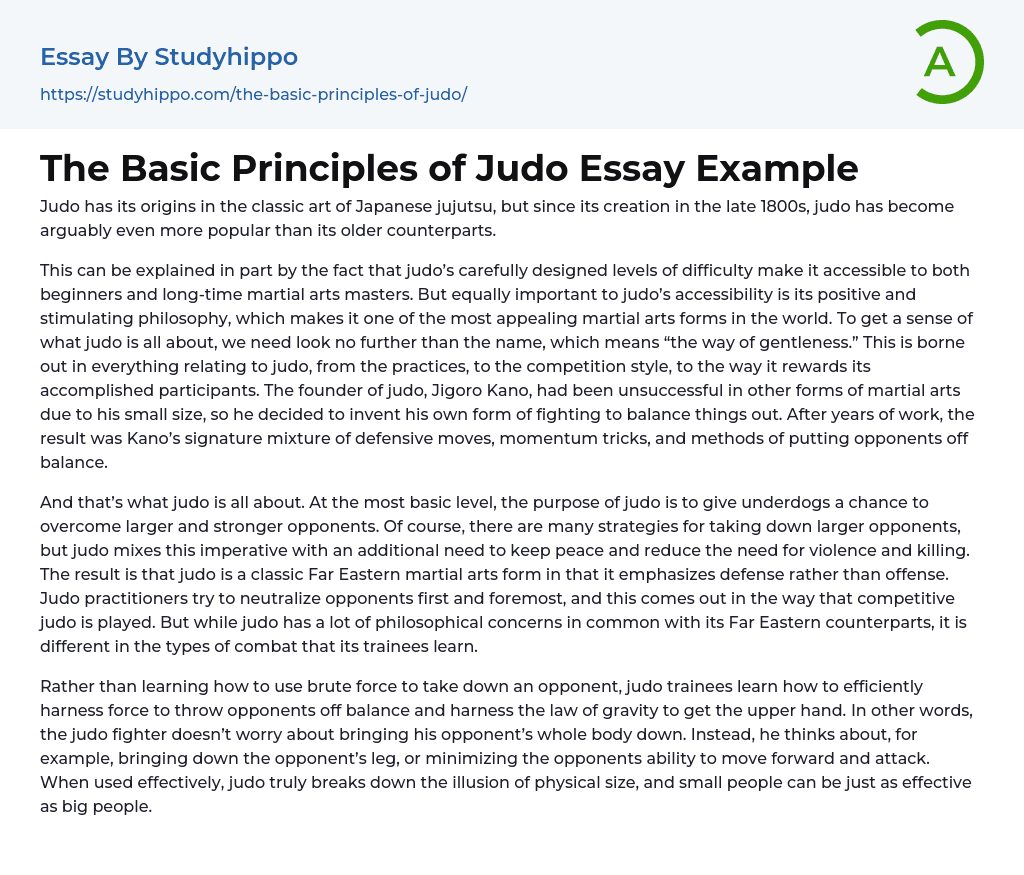Judo has its origins in the classic art of Japanese jujutsu, but since its creation in the late 1800s, judo has become arguably even more popular than its older counterparts.
This can be explained in part by the fact that judo’s carefully designed levels of difficulty make it accessible to both beginners and long-time martial arts masters. But equally important to judo’s accessibility is its positive and stimulating philosophy, which makes it one of the most appealing martial arts forms in the world. To get a sense of what judo is all about, we need look no further than the name, which means “the way of gentleness.” This is borne out in everything relating to judo, from the practices, to the competition style, to the way it rewards its accomplished participants. The founder of
...judo, Jigoro Kano, had been unsuccessful in other forms of martial arts due to his small size, so he decided to invent his own form of fighting to balance things out. After years of work, the result was Kano’s signature mixture of defensive moves, momentum tricks, and methods of putting opponents off balance.
And that’s what judo is all about. At the most basic level, the purpose of judo is to give underdogs a chance to overcome larger and stronger opponents. Of course, there are many strategies for taking down larger opponents, but judo mixes this imperative with an additional need to keep peace and reduce the need for violence and killing. The result is that judo is a classic Far Eastern martial arts form in that it emphasizes defense rather than offense. Judo practitioners try to
neutralize opponents first and foremost, and this comes out in the way that competitive judo is played. But while judo has a lot of philosophical concerns in common with its Far Eastern counterparts, it is different in the types of combat that its trainees learn.
Rather than learning how to use brute force to take down an opponent, judo trainees learn how to efficiently harness force to throw opponents off balance and harness the law of gravity to get the upper hand. In other words, the judo fighter doesn’t worry about bringing his opponent’s whole body down. Instead, he thinks about, for example, bringing down the opponent’s leg, or minimizing the opponents ability to move forward and attack. When used effectively, judo truly breaks down the illusion of physical size, and small people can be just as effective as big people.
- Mixed Martial Arts essays
- American Football essays
- Athletes essays
- Athletic Shoe essays
- badminton essays
- Baseball essays
- Basketball essays
- Benefits of Exercise essays
- Bodybuilding essays
- Boxing essays
- cricket essays
- Fight club essays
- Football essays
- go kart essays
- Golf essays
- Gym essays
- hockey essays
- Martial Arts essays
- Motorcycle essays
- Olympic Games essays
- Running essays
- scuba diving essays
- Ski essays
- snowboarding essays
- Soccer essays
- Sportsmanship essays
- Super Bowl essays
- Surfing essays
- Swimming essays
- Table tennis essays
- Taekwondo essays
- Tennis essays
- Training essays
- Volleyball essays
- wrestling essays
- Yoga essays
- Attitude essays
- Goals essays
- Personal Goals essays
- Personal Life essays
- Personality essays
- Principles essays
- Reputation essays
- Self Awareness essays
- Self Esteem essays
- Self Reflection essays
- Self Reliance essays
- Strengths essays
- Value essays
- Values essays




